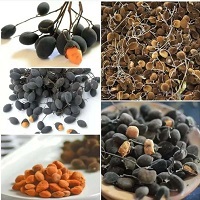African Black Velvet Tamarind Fruit & Juice
African Black Velvet Tamarind Fruit & Juice; How to make black velvet tamarind juice
Please watch this ONE-minute video below for a practical example >>>>>
About Tamarind Fruits and Its Health Benefits ~ an Overview
Black velvet tamarind, also known as African velvet tamarind, is an indigenous fruit. It has been consumed by people of all ages because it is a vitamin C supplement.
The tamarindo fruit inside the shell is either dried or pulpy, with a sweet-sour flavor; it is high in nutrition, which promotes health and helps manage some health conditions.
It ripens seasonally from January to May, with a peak yield in March and April. It is used in cooking and can also be made into drinks, beverages, jam, alcoholic beverages, syrup, and other products.
Africa n Velvet Tamarind

Velvet tamarind is a flowering plant family seasonal, tall, tropical, fruit-bearing tree. It has small, grape-sized edible fruits with hard, inedible black shells.
In West African countries, the black velvet tamarind (dialium guineese) is known by a variety of names.
Its leaf extract inhibits the growth of the parasite that causes malaria, Plasmodium falciparum. According to medical experts, consuming a concoction of the leaf could cure chronic malaria.
What is Black Velvet Tamarind? (Origin)
Black velvet tamarind is a seasonal fruit native to Africa, particularly in tropical areas such as West African countries. Its scientific name is Dialium indium or Wild Dialium Guineense.
It is commonly referred to as Nigerian velvet tamarind or African velvet tamarind and is known locally as Icheku in Igbo, Awin in Yoruba, and tsamiya-kurm in Hausa. Some people refer to it as licki-licki.
It is also known as Yoyi and is grown in other African countries such as Senegal and Ghana, and its cultivation has spread to other tropical Asian countries such as Malaysia, Indonesia, and Thailand.
Its physical characteristics include a hard and brittle black velvet shell, orange pulp that is sticky when wet, and a brown circular flat seed.
Black Velvet Tamarind Fruit Tree
Dialium guineense, also known as the velvet tamarind, is a tall, tropical, fruit-bearing tree in the flowering plant family Fabaceae. It has edible, small, grape-sized fruits with brown, hard, inedible shells.
How do you consume black tamarind?
The shell is black velvety thin and covered in an orange “powdery” pulp that protects a tiny hard seed.
With your fingers, break off a piece of the pulp and eat around the seeds. Fresh tamarind fruit can be sweet, acidic, or tart.
When the fruit is slightly unripe, it is sourer, and it becomes sweeter as the pod ages.
What is black tamarind used for?
Its partially dried fruit is used in the production of medicine. Tamarind is used to treat constipation, liver and gallbladder problems, and stomach disorders.
It is also employed in the treatment of colds and fevers.
Tamarind Fruit Benefits ~ What Are The Benefits Of Drinking Tamarind Juice?
What are the 6 main health benefits of tamarind?
- A rich source of antioxidants.
- May have anticancer properties.
- Offers liver-protective benefits.
- May improve heart health and cholesterol.
- Provides natural antimicrobial benefits.
- May offer anti-diabetic effects.
Nutritional Values of Black Velvet Tamarinds (pulp)
| Component | Values |
| Total carbohydrate | 86.6 |
| Moisture | 4.9 |
| Organic matter | 98.2 |
| Dry matter | 95.1 |
| Crude protein | 4.2 |
| Crude fat | 2.6 |
| Crude fiber | 2.2 |
| Ascorbic acid | 35.7 |
| Ash | 1.8 |
Nutritional Values of Black Velvet Tamarinds (seed)
| Component | Values |
| Total carbohydrate | 70.6 |
| Moisture | 5.9 |
| Organic matter | 97.5 |
| Dry matter | 94.1 |
| Crude protein | 15.7 |
| Crude fat | 5.4 |
| Crude fiber | 6.6 |
| Ascorbic acid | 6.4 |
| Ash | 2.5 |
What are the medicinal properties of black velvet tamarind leaves? What are the health benefits of black velvet tamarind leaves?
Velvet tamarind is high in vitamins A and C, both of which are necessary for energy production.
It also contains iron and calcium, which aid in immunity and bone health. Its leaf extract prevents the growth of the parasite Plasmodium falciparum, which causes malaria.
Downsides of Black Velvet Tamarind ~ what are the side effects of black velvet tamarind?
Many people are allergic to the ingredients in this fruit and develop symptoms such as rashes, itching, inflammation, stinging sensation, lightheadedness, fainting, vomiting, shortness of breath, and so on after consuming it
The Bottom Line on Tamarind Fruit
Because it is a seasonal fruit, Black Velvet Tamarind is not as common as other fruits such as oranges, bananas, apples, and so on, and it is often overlooked by many people. Nonetheless, it contains more vitamins than many popular fruits and has additional health benefits.
People also ask
Is tamarind a fruit?
Tamarind is a type of tropical fruit used in many dishes around the world.
What are the benefits of black velvet tamarind fruit? Tamarin Fruit benefits
Velvet tamarind is high in vitamins A and C, both of which are necessary for energy production.
Tamarind also contains iron and calcium, which aid in immunity and bone health.
Its leaf extract prevents the growth of the parasite Plasmodium falciparum, which causes malaria.
In what countries does velvet tamarind grow?
Dialium cochinchinense, also known as the velvet tamarind, is a plant species in the Fabaceae family.
It is found in Ghana, Nigeria, Sri Lanka, Cambodia, Laos, Malaysia, Myanmar, Thailand, Vietnam, and many West African countries. It is threatened by habitat loss.
What is the local name for tamarind in Nigeria? What is the Yoruba name for tamarind fruit?
Black Velvet Tamarind, also known as Awin in Yoruba, Icheku in Igbo, and Tsamiyar kurm in Hausa, is high in potassium and vitamin C, which helps regulate heart rate and blood pressure
What are the disadvantages of black velvet tamarind?
Many people are allergic to the ingredients in this fruit and develop rashes, itching, inflammation, stinging sensations, lightheadedness, fainting, vomiting, shortness of breath, and other symptoms after consuming it.
Is black tamarind beneficial to one’s health?
Tamarind polyphenols have antioxidant and anti-inflammatory properties. These can help prevent diseases like heart disease, cancer, and diabetes.
What happens to your body after you eat tamarind?
Tamarind contains a lot of magnesium. It also has more calcium than many other plant foods.
The combination of these two minerals, combined with weight-bearing exercise, may aid in the prevention of osteoporosis and bone fractures.
To use calcium, the body requires vitamin D.
Is tamarind good for your kidneys? Does tamarind cleanse the kidneys?
Tamarind’s cleansing properties aid in kidney detoxification. It has edible, small, grape-sized fruits with brown, hard, inedible shells.
African velvet tamarind leaves
Velvet tamarind is high in vitamins A and C, both of which are necessary for energy production.
It also contains iron and calcium, which aid in immunity and bone health. Its leaf extract prevents the growth of the parasite Plasmodium falciparum, which causes malaria.
African velvet fruit ~ what is the benefit of velvet fruit?
Velvet tamarind is high in vitamins A and C, both of which are necessary for energy production. It also contains iron and calcium, which aid in immunity and bone health.
Its leaf extract inhibits the growth of the parasite that causes malaria, Plasmodium falciparum.
Velvet tamarind for sale ~ Black Velvet Tamarind – Per 800g (Sweet)
₦2, 500.00
Category: Fruits Tags: Agricultural Store,
The potassium content of tamarind is sufficient to flush out the toxic elements that accumulate in the kidneys.
As a result, tamarind should be consumed once daily to keep the kidneys healthy.
What is velvet fruit?

The velvet fruit tamarind, Dialium guineense, is a tall, tropical, fruit-bearing tree in the flowering plant family Fabaceae.
Because black velvet tamarind is beneficial to the body, those with a history of gastric ulcers should consume it in moderation so as not to aggravate the condition.
This fruit should be consumed in moderation by diabetic patients.
Though it is beneficial in lowering blood sugar levels, it may cause them to be lower than normal rather than regulating them.
What is the English name of velvet tamarind? Black velvet tamarind botanical name
Dialium guineense
Botanical information: Velvet tamarind, also known as black velvet, is a common name for Dialium guineense, a legume genus in the Fabaceae family and the Caesalpinioideae subfamily.
Black velvet tamarind seed
Dialium Guineense, or black velvet tamarind, is a common tamarind with a black velvety hard shell, orange sticky pulp, and a flat circular brown seed.
It can be consumed fresh, dried, or soaked in water and then consumed.
Where to Buy Black velvet tamarind
Local markets as well as online retailers


